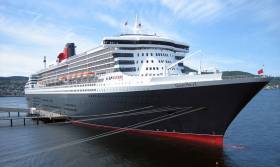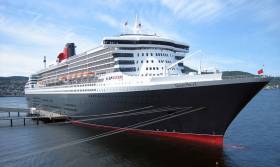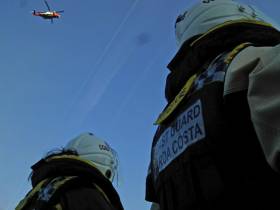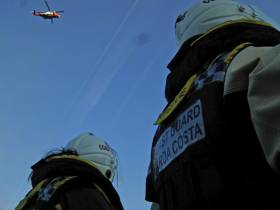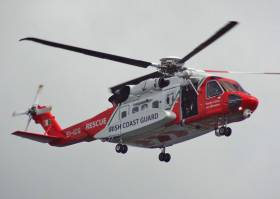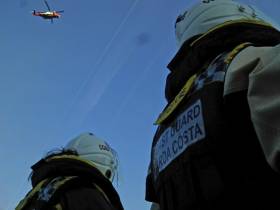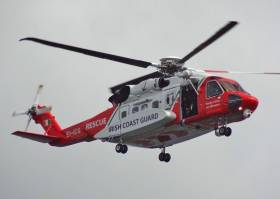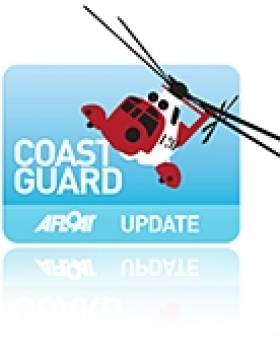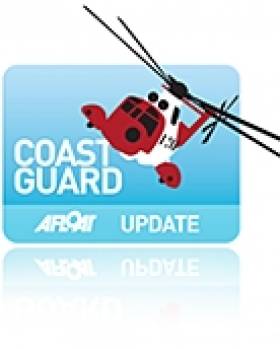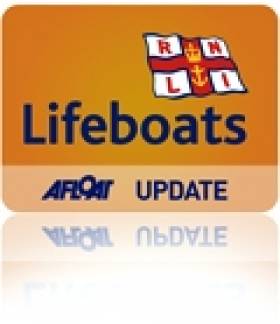Displaying items by tag: Rescue 115
Medevac From Queen Mary 2 Off Irish Coast Is Second In 13 Months
The Clare Herald reports on a helicopter medevac from the Queen Mary 2 off the Irish coast earlier this week.
Rescue 115 from the Irish Coast Guard was involved in the evacuation of an elderly woman to University Hospital Limerick from the luxury ocean liner on Monday afternoon (19 November).
The incident came just over a year after an elderly man with a suspected heart problem was evacuated from the same liner off West Cork.
Elderly Passenger In Medevac From Queen Mary 2 Off Cork
#Medevac - Shannon’s Irish Coast Guard helicopter Rescue 115 was involved in a medevac from the cruise liner Queen Mary 2 some 60 nautical miles off West Cork on Thursday morning (12 October), as BreakingNews.ie reports.
An elderly passenger understood to have a heart problem was treated by the ocean liner’s medical staff before transfer to the coastguard crew, who airlifted him to University Hospital Tralee.
Items Found On Mayo Beach Could Belong To Missing Rescue 116 Crew
#Rescue116 - A lifejacket and helmet washed up on a beach near Blacksod in Co Mayo this weekend may belong to one of the two missing crew from the Rescue 116 tragedy earlier this year, as RTÉ News reports.
The items, which were attached together, were discovered on the shore near An Clochar yesterday morning (Saturday 30 September).
A detailed search of the area has been hampered by poor weather, with no other items found.
Winch operator Paul Ormsby and winchman Ciaran Smith have been missing since the Irish Coast Guard helicopter went down at the island of Black Rock, west of Blacksod, on 14 March.
Capt Dara Fitzpatrick was recovered at the scene but was pronounced dead in hospital shortly after. The body of Capt Mark Duffy was recovered some days later.
Elsewhere, the body of a middle-aged man was found washed up on Inis Meáin in Galway Bay last night.
RTÉ News says the discovery comes almost a fortnight to the day after a Russian national was swept into the water while sea angling near Doonbeg, some 36km south of the Aran Islands.
There was better news for the families of two fishermen feared missing in Galway Bay overnight, as the Irish Examiner reports.
Aran Islands RNLI and the Shannon-based coastguard helicopter Rescue 115 were involved in the search last night and early this morning for the pair when they were reported overdue.
But the search was called off around 10.30am when the small fishing boat, which has suffered technical issues in “challenging” conditions, returned to port under its own power.
Rescue 115 was earlier requested for a medevac from Inis Mór to University Hospital Galway.
#Skibbereen - TheJournal.ie reports that a 14-year-old boy is in critical condition after he was struck in the head by a boom while yachting off Skibbereen yesterday morning (Saturday 24 June).
The teenager was airlifted to Cork University Hospital by the Irish Coast Guard helicopter Rescue 117, and the latest news from Independent.ie is that his condition was improving.
Elsewhere yesterday, Howth Coast Guard attended a 53-year-old man with serious head injuries sustained while kitesurfing off Sutton in North Co Dublin.
And Shannon’s Rescue 115 was called to Inis Mór in the Aran Islands for the medevac of a woman who suffered spinal injuries while taking part in the Red Bull Cliff Diving World Series event.
Medevacs For Injured Fishermen Off Cork & Clare
#Medevac - The Irish Coast Guard launched to separate medevacs for fishermen who sustained injuries off the Cork and Clare coasts this weekend, as BreakingNews.ie reports.
In Cork yesterday (Sunday 2 April), the Shannon-based coastguard helicopter Rescue 115 airlifted a fisherman with serious hand injuries from a fishing trawler some 20km south of Mizen Head.
The day before (Saturday 1 April), Rescue 115 flew to a trawler off the Clare coast to retrieve a fisherman who a leg injury for treatment at University Hospital Limerick.
BreakingNews.ie has more on the story HERE.
Coastguard Helicopters In Monday Morning Medevacs
#Coastguard - Irish Coast Guard helicopters were called on for two separate evacuations from fishing vessels yesterday morning (Monday 16 January).
In the first incident, Waterford-based Rescue 117 airlifted a fisherman who had suffered an injury on board his vessel to University Hospital Waterford.
On the same morning, Rescue 115 from Shannon was tasked to retrieve a casualty from a fishing vessel some 120 miles west of Kerry Head and transport him to University Hospital Limerick.
MEDICO Cork, based at Cork University Hospital’s A&E department, provided advice for both coastguard medevacs.
Coastguard In Medevac From Irish Fishing Vessel
#Coastguard - Shannon's Irish Coast Guard helicopter was launched yesterday afternoon (Tuesday 14 June) to evacuate an injured crewmember from an Irish fishing vessel off the Kerry coast.
Top cover was provided by a second coastguard helicopter as Rescue 115 flew to the boat 120 miles west of the Blasket Islands to recover the injured party for treatment.
In another incident, coastguard volunteers recovered the body of a man from the base of the Cliffs of Moher last night, as BreakingNews.ie reports.
Units from Doolin and Kilkee responded when the alarm was raised around 5pm yesterday, eventually lifting the body to the cliff top four hours later. Gardaí are investigating.
#Coastguard - As the Facebook post above shows, the Irish Coast Guard has officially named the Shannon-based helicopter with the call sign Rescue 115 as Banríon na Spéire, or Queen of the Sky.
The search and rescue chopper, which was delivered to Shannon in February 2012, was the first of the coastguard's new fleet of Sikorsky S92 aircraft to go into service.
#Coastguard - What would have been the Irish Coast Guard's longest ever rescue mission was stood down at the last minute after the casualty in question was deemed to be in a stable condition.
According to the Irish Independent, the Shannon-based coastguard rescue helicopter was dispatched on the 300-nautical-mile mission to retrieve a man in his 70s from a cruise liner en route to Cobh from the United States.
The distance was so great that the helicopter, the new Sikorsky S-92 with the call sign Rescue 115, was forced to land on an offshore oil rig 180km off Kerry to refuel.
While there the chopper experienced a technical issue and was grounded for safety reasons while an engineer was sent to the oil rig on board Waterford's Rescue 117.
However, in the meantime a second doctor on board the MS Marina determined that the patient - who was feared to have had a stroke - was in a stable enough condition to be transferred to hospital upon the ship's arrival in Cobh early today.
The Irish Examiner confirms that the casualty was a 79-year-old American.
Aran Islands RNLI Rescue Fishermen in Galway Bay
#RNLI - Aran Islands RNLI in Galway Bay assisted six fishermen from a 24m trawler yesterday Thursday 18 April.
The volunteer lifeboat crew launched their all-weather lifeboat at 4.20pm following a report that a fishing vessel, the Archangel, with six crew on board had got into difficulty and broken down one mile north west of Inishmore.
There was a six-metre swell at the time with a force seven to eight wind.
The lifeboat crew under coxswain John O’Donnell arrived on scene accompanied in the air by Irish Coast Guard helicopter Rescue 115 - the subject of its own documentary TV series currently showing on RTÉ One - and established a tow line removing the vessel from any immediate danger.
The trawler was then towed back to Rossaveal in Connemara.
Speaking following the call-out, Aran Islands RNLI lifeboat operations manager Michael Hernon said: "Thanks to the speed and efficiency of the crew in launching the lifeboat, we were able to arrive on scene in good time to assist the fishermen and successfully tow the trawler safely to shore."


























